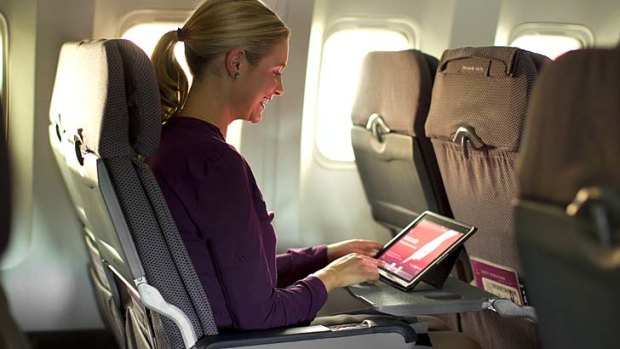This was published 11 years ago
Why aren't we getting inflight internet?

Qantas has scrapped its plans for inflight internet on A380 flights.
You can send emails aboard most US domestic airliners for as little as $US1.95 for 15 minutes.
The competition is fierce and no-one appears to be making money out of the service. The takeup rate is also miniscule, with just four per cent of flyers reportedly using it.
But airborne wi-fi was demanded mainly by business flyers, so it was provided.
Internationally, demand is also there, especially among business flyers, so leading airlines, like Singapore Airlines and Emirates, have jumped on board as the technology has become available, with rates starting at $US7.50 for basic access. Among the international carriers flying here, Cathay Pacific has promised a service and Qatar Airways has it aboard its new Boeing 787s, which begin flying to Perth this month.
But using a foreign airline is the only way you can now access inflight internet in Australian skies following Qantas’s decision to abandon its trial aboard A380s from Sydney and Melbourne to Singapore and London and, in the other direction, to Los Angeles.
Qantas said fewer than five per cent of passengers had accessed the serviced during the trial, according with international experience.
But the airline has decided it isn’t worth the hundreds of thousands of dollars per aircraft it must spend to provide the service.
"Naturally, the costs associated with offering a reliable internet connection in-flight are significantly higher than on the ground, particularly when you are flying over vast expanses of ocean and can't connect to ground towers," a Qantas spokesman told Fairfax.
The airline points out most of its A380 flights are overnight services and the vast majority of its customers prefer to sleep.
Qantas charged between $12.90 and $39.90 for its data packages in the trial – significantly more than the competition.
The airline says it is now concentrating on upgrading wi-fi access for its customers on the ground. Several months ago, the airline introduced free wi-fi access at its terminals in Melbourne, Sydney, Brisbane and Perth.
Qantas’s new international partner, Emirates, has introduced the same technology on its A380 superjumbos with rates starting at $US7.50 for customers using five megabytes of data on their own mobile phones.
Virgin Australia’s partner Singapore Airlines (SIA) starting rates are also cheaper than Qantas’s at $US10 for 10 megabytes.
For the past two decades, Emirates and SIA have always been at the forefront in introducing the latest in-flight gadgets and it has paid off, particularly in Australia.
Emirates began its global marketing campaign two decades ago with the promise of video in every seat. Similarly, SIA gambled on new inflight entertainment (IFE) systems long before they were a proven product.
In the 1990s, IFE systems were full of wires that ran hot and sucked up a huge amount of the available onboard power – apart from anything, just to cool them down. And they were always breaking down; unserviceable IFE become the bane of of the lives of both airlines and their customers.
Qantas was one of the Western airlines that stood back and waited for the technology to become reliable before adopting it – and there’s no doubt who won that battle.
Emirates now has rights to operate more than 20 services a day to Australia and the Australasian region (Australia and New Zealand) now accounts for about a third of its global revenue.
Qantas appears to have made a sound commercial decision about the commercial potential of onboard wi-fi. It’s apparent that it’s never going to be a money-spinner – or at least it won’t be for some time until the cost of the technology comes down.
But it appears it has also given its key competitors another advantage with which to chip away at Qantas’s international market share on services to and from Australia.
Meanwhile, inside Australia, neither Qantas or Virgin Australia appear the least bit interested in providing wi-fi on domestic flights. Both are putting more effort into introducing onboard wi-fi designed just to run IFE applications without the telecommunications applications.
Is airborne wi-fi really a deal-breaker for you if it’s not provided? Would you change brands just so you can have it? Are you the type that would be happy to spend hours on the web? What about domestic wi-fi access? Post your comments below.
Sign up for the Traveller Deals newsletter
Get exclusive travel deals delivered straight to your inbox. Sign up now.